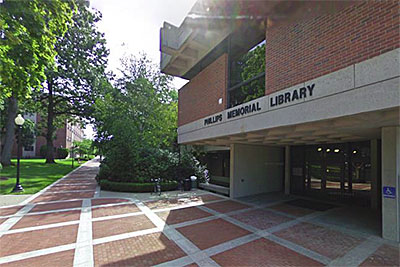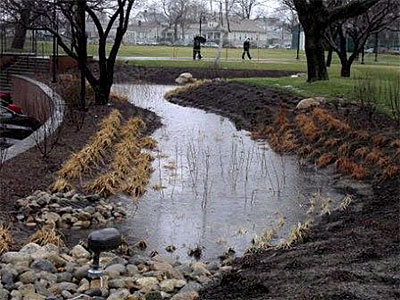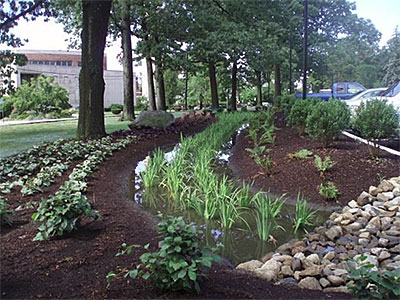
The source of the runoff that flows into the subsurface infiltration system at Phillips Library.

The Ruane Center bioretention system.

The Slavin Center Bioretention system.

The St. Martin bioretention basin.
Project: Providence College
Location: Providence Map It
Description:
Phillips Library
The subsurface infiltration system reduces stormwater runoff into the Narragansett Bay Commission’s combined sewer system in Eaton Street. It consists of 50 polyethylene stormwater collection chambers, which infiltrate runoff directed to the system from one-quarter of the Phillips Library roof and 900 square feet of impervious ground cover to the west of the building. Located beneath the driveway linking parking lots to the south of the library and Hickey/ Albertus Magnus/ Sowa Halls, the system was designed to infiltrate flows up to and including a 25-year storm event.
Ruane Center
The Ruane Center bioretention is a four-cell stormwater filtration system that treats runoff from the Ruane Center roof and reduces runoff to the city storm sewers. The upper three cells store 6’ of water before spilling into each successive cell. The final cell stores 9’ of water. A forebay dissipates the energy of incoming water while treatment occurs by filtration through an organic surface layer (aged, shredded hardwood mulch) and soil media bed, biological activity/plant uptake of nutrients, attenuation (sediment retention), and infiltration.
Slavin Center
The bioretention basin system is designed to capture and filter stormwater runoff from a 3.5 acre subwatershed, including the Slavin Center lobby roof, walkways and landscape areas on the south side of Slavin Center. Filtering systems capture and temporarily store the water volume prior to filtering it though a soil media. The storm water from the Slavin Center lobby roof drains and collected overland flow from the south side of the building filters through wetland plantings and bioretention soil that removes pollutants. Filtered stormwater is collected in an underdrain and discharged to a storm drain pipe towards River Avenue. Larger storm events will produce stormwater faster than the infiltration rate of the bioretention basin soil (2.41 in/hr) and cause the ponding depth within the basin to rise until stormwater is discharged through the overflow structure.
- Bioretention basin system
- Serves 3.5 acre subwatershed
- Runoff sources: Lobby roof, walkways, landscape areas
- Runoff captured and stored before filtering
- Filtered through soil media and wetland plantings
- Discharged to drain pipe to River Ave.
- Pond level can rise until runoff discharged
Drainage Area 86,250 sq. ft.
Water Quality Volume (WQv) 1,706 ft3 (12,762 gal.)
Treatment Volume (WQ storm) 1,706 ft3 (12,762 gal.)
St. Martin Hall
The bioretention basins are stormwater filtration systems that treat runoff from the parking lot located in front of St. Martin Hall. Stormwater is directed to two paved waterways located at the southern corners of the parking lot. Runoff is conveyed to sediment forebays, which serve as pretreatment and provide approximately 6” of water quality volume storage. Sediment forebays are separate cells containing rip rap in order to dissipate energy flows and trap sediment particles. Flows are directed over the sediment forebay embankment to the bioretention basin cells, where stormwater is filtered through hardwood mulch and engineered soil media, nutrients are removed through plant uptake. The bioretention system is designed to infiltrate stormwater and reduce the campus’s output of runoff into the Narragansett Bay Commission sewer system.
- Treats parking lot runoff
- Bioretention basins
- Runoff directed to 2 sediment forebays
- Each can hold 6” of runoff water